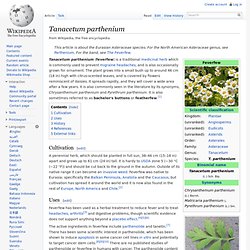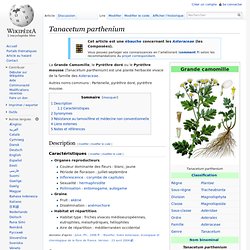

Feverfew. This article is about the Eurasian Asteraceae species.

For the North American Asteraceae genus, see Parthenium. For the band, see The Feverfew. Tanacetum parthenium (feverfew) is a traditional medicinal herb which is commonly used to prevent migraine headaches, and is also occasionally grown for ornament. The plant grows into a small bush up to around 46 cm (18 in) high with citrus-scented leaves, and is covered by flowers reminiscent of daisies. It spreads rapidly, and they will cover a wide area after a few years. Cultivation[edit] A perennial herb, which should be planted in full sun, 38–46 cm (15–18 in) apart and grows up to 61 cm (24 in) tall. Uses[edit] Leaves of Feverfew Feverfew has been used as a herbal treatment to reduce fever and to treat headaches, arthritis[3] and digestive problems, though scientific evidence does not support anything beyond a placebo effect.[4][5][6] History[edit] References[edit] External links[edit]
Savoir Comment Faire un Bébé et savoir Comment Tomber enceinte en moins de 2 mois. Aujourd'hui, je veux vous aider à tomber enceinte !

Madame, Mademoiselle, Vous avez du mal à tomber enceinte? J’ai lutté contre ma soi-disant stérilité pendant des années jusqu’à ce que je trouve une solution. Êtes-vous dans cette situation : Vous avez entre 30 et 49 ans ? Alors, lisez attentivement cette page. Moi aussi j'avais perdu tout espoir car mon gynécologue ainsi que de nombreux autres spécialistes m'affirmaient que je n'aurais jamais d'enfant. Mais j'y suis arrivée! Je vais vous aider à tomber enceinte : Je m’appelle Sandra Morin. Au cours des 9 dernières années, j’ai développé une méthode pour tomber enceinte rapidement et naturellement. Je suis tombée enceinte deux fois et je suis fière aujourd'hui d’être une maman de deux beaux enfants qui sont en bonne santé. Ma méthode est cliniquement étudiée et soutenue par l'expertise de médecines alternatives. Des centaines de femmes ont utilisé ma méthode pour tomber enceinte. « C’est à 42 ans que j’ai enfin pu tomber enceinte... » Sandra,
Migraine Treatment. Elderberries As soon as you feel a migraine starting, put 10 to 15 elderberries in 1 cup of water.

Mash the berries and bring to a quick boil. Reduce the heat and simmer for about 10 minutes. Strain, sweeten, and then drink it. Thyme Mix 1 teaspoon of dried herb per cup of hot water. Flaxseed An excellent natural migraine treatment because this rich source of essential fatty acids changes your body chemistry in a way that makes you produce fewer harmful prostaglandins, the hormonelike chemicals in the blood that cause constriction of blood vessels and increase sensitivity to pain.
Vinegar Mix equal parts of water and vinegar and bring it to a boil. Purslane This food contains high amounts of magnesium. Tansy Like feverfew, tansy contains parthenolides which help prevent migraines. Evening Primrose Another great natural migraine treatment, evening Primrose contains a high amounts of phenylalanine, an extremely effective natural pain reliever. Lemon Coffee Skullcap and Rosemary Lemon Balm. Feverfew and Migraine. Migraine Fact Sheets Feverfew is a popular herbal remedy used by people who experience migraine.

This fact sheet looks at how feverfew may help you. What is feverfew? Feverfew (Tanacetum parthenium) is a perennial plant belonging to the daisy family which grows in much of Europe, North America and Canada. It has been used in herbal remedies for centuries. Why do people use herbal remedies? You may decide to turn to herbal remedies to help control your migraines because: you feel you have run out of options with conventional medicine; herbal remedies will be “more natural” or you feel they are simply more helpful and appropriate for your condition. Can feverfew help with migraines? Feverfew is used as a preventative (or prophylactic) treatment for migraine. Until recently only a few scientific studies into the use feverfew had been conducted, and those few had been small in scale.
How should I take feverfew? Freeze dried capsules Feverfew capsules can be bought from chemists and health stores. Tanacetum parthenium. Un article de Wikipédia, l'encyclopédie libre.

La Grande Camomille, le Pyrèthre doré ou le Pyrèthre mousse (Tanacetum parthenium) est une plante herbacée vivace de la famille des Asteraceae. Autres noms communs : Partenelle, pyrèthre doré, pyrèthre mousse. Description[modifier | modifier le code] Caractéristiques[modifier | modifier le code] Organes reproducteursGraineFruit : akèneDissémination : anémochoreHabitat et répartitionHabitat type : friches vivaces médioeuropéennes, eutrophiles, mésohydriques, héliophilesAire de répartition : méditerranéen occidental données d'après : Julve, Ph., 1998 ff. - Baseflor.